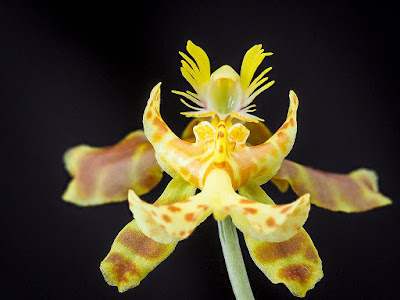Psychopsiella limminghei is native to Venezuela and Brazil. The reference plant for this species was found near Caracas in Venezuela, but since then it has been found only in the state of Rio de Janeiro in Brazil...
Psychopsiella limminghei also called as Limminghe's Psychopsiella, Oncidium echinophorum, Oncidium limminghei, Psychopsis limminghei, is a species of the genus Psychopsiella. This species was described by Lückel & Braem in 1982.
IDENTIFY PSYCHOPSIELLA LIMMINGHEI
Psychopsiella limminghei is native to Venezuela and Brazil. The reference plant for this species was found near Caracas in Venezuela, but since then it has been found only in the state of Rio de Janeiro in Brazil.
It is a dwarf epiphyte with pseudobulbs and leaves that grow flat against the tree with small heart shaped, overlapping, compressed, 2 cm long and 1.5 cm wide pseudobulbs enveloped basally by several white, prominently nerved sheaths that are evanescent with 2, elliptic, obtuse mottled red, dull green, 3.5 cm long and 3.5 cm wide leaves.
Limminghe's Psychopsiella blooms in the late spring through fall from the ascending rhizome and the erect to arcuate, basal, 15 cm long, one to 5, successively flowered, wiry inflorescence that has lanceolate, acute bracts and all arising with a new growth. The flowers are 3-4 cm in diameter and are large in relation to the size of the whole plant. The lateral outer petals are slightly smaller and the wider petals of the inner whorl are slightly larger. Side plots, after unfolding, are rounded, with the base rather narrow, usually straight, and their ends bend inward. A relatively narrow isthmus separates them from the middle plot. The three-flap lip is slightly narrower than the kidney-shaped central plot, which can be turned upside down or have slightly bent edges. The concave ridge petal and the slightly curved petals of the inner whorl are vivid, reddish-brown and have more or less strips of yellow-green or light-brown. The side petals of the ovoid shape are not so brightly colored. The lip is yellow with orange-brown dots and spots. The yellowish-white thickening between the side parcels has 3 ridges and orange-brown spots. The spine is yellow, with wide, strongly curled, yellow wings. The pollen chamber cover is creamy-yellow, and each flower produces 2 hard, yellow anthers.
PSYCHOPSIELLA LIMMINGHEI CARE AND CULTURE
Cultural information should only be used as a guide, and should be to be adapted to suit you. Your physical location; where you grow your plants, how much time you have to devote to their care, and many other factors, will need to be taken into account. Only then can you decide on the cultural methods that best suit you and your plants.
Light:
Psychopsiella limminghei needs a light level of 18000-25000 lux. The light should be filtered and dispersed, and the plants should not be exposed directly to the sun in the afternoon hours. Strong air movement should be ensured all the time.
Temperature:
It is a thermophilic plant. The average temperature of the day in the summer of 25-27 ° C, at 19-20 ° C at night, which gives a daily difference of 6-7 ° C. The average winter temperature is 21-22 ° C, at night 14-15 ° C, with a daily amplitude of 7 ° C.
Humidity:
Limminghe's Psychopsiella needs the humidity of 75-80% throughout the year.
Substrate, growing media and repotting:
Psychopsiella limminghei is probably growing best closely attached to a piece of cork. Such cultivation requires, however, maintaining high humidity, and in the summer of daily watering. During very hot, dry weather, plants so assembled may require several fogs a day.
These plants can also grow in flat pots or baskets, using a loose, quick-drying substrate. The roots need to dry quickly after watering, which is why a substrate with excellent drainage is so important. Even with excellent drainage, it may be beneficial to mount the plant on a piece of cork and then insert one end of such a plant into a pot or basket.
You can repot or divide the plants only at the beginning of the appearance of new roots, which allows the plant to become established in the shortest possible time with the least amount of stress.
Watering:
For most of the year, rainfall is moderate to heavy, but in winter the conditions change to a little more dry. The cultivated plants should be abundantly watered during active growth, but excellent drainage should be ensured so that the substrate within the roots is not degraded or soggy.
Fertilizer:
During the active growth, the plants should be fertilized every week 1/4-1/2 of the recommended dose of fertilizer for orchids. You can use balanced fertilizer throughout the year, but also can use fertilizer with increased nitrogen content from spring to mid summer, and then in the late summer and autumn, use a fertilizer with a higher content of phosphorus.
Rest period:
In winter, Psychopsiella limminghei need less water, so the period between waterings should be extended, but they can never be completely dry for more than a week. Fertilization should be reduced or completely eliminated until more intense watering starts in the spring.















COMMENTS